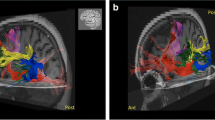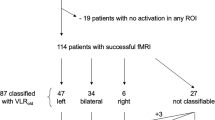Abstract
The usefulness of the intracarotid Amytal (amobarbital) procedure (also called the Wada procedure) in identifying hemispheric language dominance in pediatric patients has not been independently confirmed with intraoperative language mapping techniques. Currently, data are extrapolated from adult studies. To better establish the usefulness of the intracarotid Amytal procedure in identifying hemispheric language dominance in pediatric patients, we reviewed the records of 77 consecutive pediatric patients who underwent sodium amobarbital testing. Among these 77 subjects, 34 underwent intraoperative language mapping, the results of which all completely confirmed the Amytal results. It was also shown that among these pediatric epileptic patients who underwent Amytal testing, there existed not only a strong correlation between left-handedness and atypical speech lateralization (right, bilateral hemisphere), but also between right-sided hemiparesis (i.e., early left-hemisphere injury) and atypical speech.
Similar content being viewed by others
References
Ajersch MK, Milner B (1983) Handwriting posture as related to cerebral speech lateralization, sex, and writing hand. Hum Neurobiol 2: 143–145
Ammirati M, Vick N, Liao Y, Ciric I, Mikhael M (1987) Effect of the extent of surgical resection on survival and quality of life in patients with supratentorial glioblastomas and anaplastic astrocytomas. Neurosurgery 21: 201–206
Arseni C, Petrovici IN (1971) Epilepsy in temporal lobe tumors. Eur J Neurol 5: 201–214
Berger MS, Kincaid J, Ojemann GA, Lettich E (1989) Brain mapping techniques to maximize resection, safety and seizure control in children with brain tumors. Neurosurgery 25: 786–792
Berger MS, Ojemann GA, Lettich E (1990) Neurophysiological monitoring during astrocytoma surgery. Neurosurg Clin North Am 1: 65–80
Berger EA, Berker AH, Smith A (1986) Translation of Broca's 1865 report. Localization of speech in the third left front convolution. Arch Neurol 43: 1065–1072
Berry MP, Jenkin RTD, Keen CW, Nair BD, Simpson WJ (1981) Radiation treatment for medulloblastoma: a 21-year review. J Neurosurg 55: 43–51
Binner R, Ginsberg B, Bloch E, Mason D (1992) Anesthetic management of a pediatric Wada test. Anesth Analg 74: 621–622
Bloom HJG (1982) Intracranial tumors: response and resistance to therapeutic endeavors 1970–1980. Int J Radiat Oncol Biol Phys 8: 1083–1113
Bloom HJG, Wallace ENK, Henk JM (1969) The treatment and prognosis of medulloblastoma in children: a study of 82 verified cases. AJR 105: 43–62
Branch C, Milner B, Rasmussen T (1964) Intracarotid sodium amytal for the lateralization of cerebral speech dominance. Observations in 123 patients. J Neurosurg 21: 399–405
Dodrill CB (1993) Preoperative criteria for identifying eloquent brain: intracarotid amytal for language and memory testing. Neurosurg Clin North Am 4: 211–216
Engel J Jr, Rausch R, Lieb JP, Kuhl DE, Crandall PH (1981) Correlation of criteria used for localizing epileptic foci in patients considered for surgical therapy of epilepsy. Ann Neurol 9: 215–224
Findlay JL, Uteg R, Geise WL (1987) Progress in the management of childhood brain tumors. Hematol Oncol Clin North Am 1: 753–776
Fleiss JL (1981) Statistical methods for rates and proportions. Wiley, New York, pp 24–26
Gonsales D, Elvidge AR (1962) On the occurrence of epilepsy caused by astrocytoma of the cerebral hemisphere. J Neurosurg 19: 470–482
Holmes GL (1991) Do seizures cause brain damage? Epilepsia 32: S14-S28
Holmes GL, Moshé S (1990) Consequence of seizures in the developing brain. Epilepsy 3: 7–13
Ilgren EB, Stiller CA (1986) Cerebellar astrocytomas: therapeutic management. Acta Neurochir (Wien) 81: 11–26
Laws ER, Taylor WF, Clifton MB, Okazaki H (1984) Neurosurgical management of low-grade astrocytoma of the cerebral hemispheres. J Neurosurg 61: 665–673
Loring DW, Meador K, Lee G, Murro A, Smith J, Flanigin H, Gallagher B, King D (1990) Cerebral language lateralization: evidence from intracarotid amobarbital testing. Neuropsychologia 28: 831–838
Matson DD (1968) Surgery of posterior fossa tumors in childhood. Clin Neurosurg 15: 247–262
Mazza C, Passqualin A, DaPian R, Donati E (1981) Treatment of medulloblastoma in children: long-term results following surgery, radiotherapy and chemotherapy. Acta Neurochir (Wien) 57: 163–175
Ojemann G (1979) Individual variability in cortical localization of language. J Neurosurg 50: 164–169
Ojemann GA (1987) Surgical therapy for medically intractable epilepsy. J Neurosurg 66: 489–499
Ojemann G (1987) Intraoperative functional mapping at the University of Washington, Seattle. Surgical treatment of the epilepsies. Raven Press, New York, pp 635–639
Ojemann G (1990) Organization of language cortex derived from investigations during neurosurgery. Semin Neurosci 2: 297–305
Ojemann G (1991) Cortical organization of language and verbal memory based on intraoperative investigations. Prog Sensory Physiol 12: 193–230
Ojemann G, Fried I, Lettich E (1989) Electrocorticographic (ECoG) correlates of language. I. Desynchronization in temporal language cortex during object naming. Electroencephalogr Clin Neurophysiol 73: 453–463
Ojemann G, Ojemann J, Lettich E (1989) Cortical language localization in left, dominant hemisphere. J Neurosurg 71: 316–326
Ojemann G, Cawthon D, Lettich E (1990) Localization and physiologic correlates of language and verbal memory in human lateral tempoparietal cortex. In: Scheibel AB, Wechsler AF (eds) Neurobiology of higher cognitive function. Guilford, New York, pp 185–202
Polkey CE (1989) Surgery for epilepsy. Arch Dis Child 64: 185–187
Powell EG, Polkey CE, Canavan AGM (1987) Lateralization of memory functions in epileptic patients by use of the sodium amytal (Wada) technique. J Neurol Neurosurg Psychiatry 50: 665–672
Raimondi AJ, Tomita T (1979) Medulloblastoma in childhood. Comparative results of partial and total resection. Child's Brain 5: 310–328
Rasmussen T (1975) Surgery of epilepsy associated with brain tumors. Adv Neurol 8: 227–239
Rasmussen T, Milner B (1977) The role of early left brain injury in determining lateralization of cerebral speech functions. Ann NY Acad Sci 299: 355–369
Rausch R, Walsh GO (1984) Right-hemisphere language dominance in right handed epileptic patients. Arch Neurol 41: 1077–1080
Roberts L (1955) Handedness and cerebral dominance. Trans Am Neurol Assoc 80: 143–148
Rutledge SL, Snead OC, Morawetz R, Chandra-Sekar B (1987) Brain tumors presenting as a seizure disorder in infants. J Child Neurol 2: 214–219
Stiller CA, Lennox EL (1983) Childhood medulloblastoma in Britain 1971–1977: analysis of treatment and survival. Br J Cancer 48: 835–841
Strauss E, Wada J (1983) Lateral preferences and cerebral speech dominance. Cortex 19: 165–177
Sutton LN (1987) Current management of low-grade astrocytomas of child-hood. Pediatr Neurosci 13: 98–107
Wada J (1949) A new method for the determination of the side of cerebral speech dominance. A preliminary report on the intracarotid injection of sodium amytal in man. Igaku Seibutsugaki (Medicine and Biology) 14: 221–222
Wada J, Rasmussen T (1960) Intracarotid injection of sodium amytal for lateralization of speech dominance. J Neurosurg 17: 226–282
Wasterlain CG, Fujikawa DG, Penix L, Sankar R (1993) Pathophysiological mechanisms of brain damage from status epilepticus. Epilepsia 34: S37-S53
Williams J, Rausch R (1992) Factors in children that predict performance on the intracarotid amobarbital procedure. Epilepsia 33: 1036–1041
Woods RP, Dodrill CB, Ojemann GA (1988) Brain injury, handedness and speech lateralization in a series of amobarbital studies. Ann Neurol 23: 510–518
Wyllie E, Luders H, Murphy D, Morris H, Dinner D, Lesser R, Godoy J, Kotagal P, Kanner A (1990) Intracarotid amobarbital (Wada) test for language dominance: correlation with results of cortical stimulation. Epilepsia 3: 156–161
Author information
Authors and Affiliations
Rights and permissions
About this article
Cite this article
Hinz, A.C., Berger, M.S., Ojemann, G.A. et al. The utility of the intracarotid Amytal procedure in determining hemispheric speech lateralization in pediatric epilepsy patients undergoing surgery. Child's Nerv Syst 10, 239–243 (1994). https://doi.org/10.1007/BF00301161
Received:
Issue Date:
DOI: https://doi.org/10.1007/BF00301161




